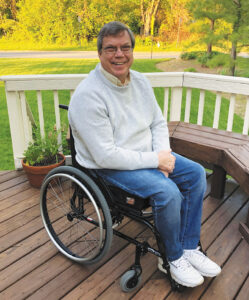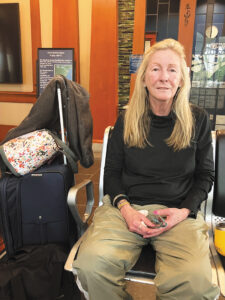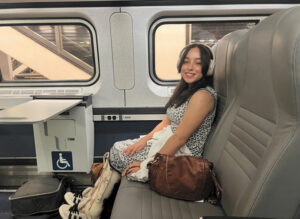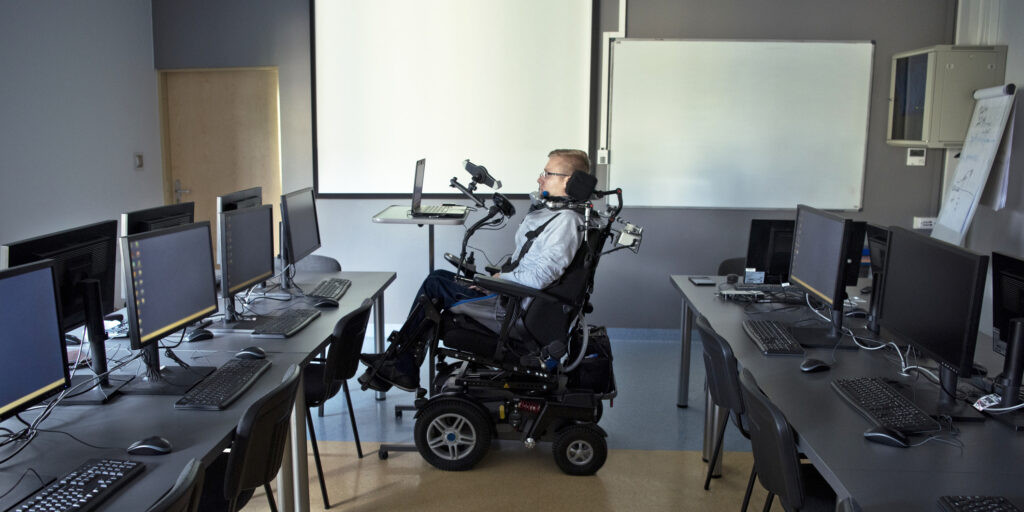
Is Train Travel a Wheelchair-Friendly Alternative to Flying or Driving?
By Steve Wright | Friday, May 23, 2025
5 Second Summary
Long-distance trains may offer a more accessible, comfortable travel experience for people with disabilities frustrated by air travel, according to community members who have been there.
When the Zelaya family travels from their home in Brooklyn, New York, to Boston or Washington, DC, they take an Amtrak train. Leah Zelaya, a former MDA National Ambassador, and her dad, Jaime, live with scapuloperoneal spinal muscular atrophy (SPSMA).

Leah (left) and Bevi Zelaya (right).
“When we travel on an airplane, we rush to get through the terminal, and I never know if my wheelchair is going to come back to me in one piece,” says Leah, a 17-year-old actor, dancer, and model who walks with bilateral leg braces and uses a wheelchair for long distances. “Using the train is like a different, stress-free world. It’s way better.”
Leah’s mom, Bevi, says that, as a caregiver, it is stressful to worry about wheelchair damage or loss during a flight.
“You can’t stay in your wheelchair on a plane, and it will be ages before you can,” Leah adds. “On the train, you have that independence.”
Train travel is a viable option for people with disabilities who are tired of having their wheelchairs mishandled in an airline industry known for treating mobility devices poorly. In 2024, a single air carrier was fined $50 million for its treatment of passengers with disabilities and their mobility equipment.
People with neuromuscular diseases and other disabilities may enjoy less hassle and a more inclusive ride on trains. Seasoned travelers point out that a regional train ride of two to four hours is just as expedient as a one-hour flight because a flight includes early arrival, security screening, and an uncomfortable boarding process involving transfers between their personal wheelchair, an aisle chair, and the plane seat. Even for long-distance routes, accessible sleeper cars can make train travel more inclusive.
Accessibility on Amtrak
David Capozzi, who uses a wheelchair, joined the Amtrak Board of Directors in 2024. The Maryland resident worked for the US Access Board for 28 years, including more than a decade as its executive director.

David Capozzi, who uses a wheelchair, is on the Amtrak Board of Directors.
David became an Amtrak board member thanks to disability rights activist and US Senator Tammy Duckworth, who pushed to require the board to include at least one person with a disability who has experience with accessibility in passenger rail. This change was made after Amtrak came under fire in 2020 for trying to charge a group of wheelchair users traveling from Chicago to Bloomington, Illinois, $25,000 to accommodate them by removing seats. A one-way ticket for that route was $16. Amtrak backed off after public outcry, but more inclusive representation on its board was needed.
“Our son and daughter-in-law live in New York City, and we take the train there often,” David says. “From the station by Baltimore/Washington International Airport, we can go right to the Moynihan Train Hall in Manhattan. It’s easier than a flight.”
David is enthused that Amtrak’s 2025 budget includes $243 million for improving compliance with the Americans with Disabilities Act (ADA) on trains and in stations. However, he understands the nation’s passenger rail agency did a poor job of addressing ADA issues in the first 20 years after the legislation passed.
“There is a lot of catching up to do, as some trains are 40 to 50 years old, and many stations are very old,” he says. Roughly half of the train stations Amtrak uses are accessible now, and 173 station construction projects are scheduled through 2029.
David prefers to use stations that have platforms level with the train, so only a portable bridge plate is needed to fill the small gap between the train and the platform. He suggests that travelers who use wheelchairs look up their Amtrak stations to learn about their accessibility before booking.
Amtrak is boosting accessibility on trains with 576 new long-distance cars, 28 next-generation Acela cars between Boston and Washington, DC, and 83 new Airo trains on several train lines. According to Amtrak, the new trains will have more spacious vestibules and restrooms, accessible café cars, and wheelchair lifts. Amtrak also offers wheelchair-accessible sleeper cars on overnight routes.
“I’ve used the accessible bedroom cars on the Auto Train,” David says, describing a special Amtrak train that transports passengers and their vehicles nonstop from Washington, DC, to Orlando. “They take my wheelchair van onto the train, offload it, and I have it in Florida without having to drive 810 miles one way,” he says.
Christopher Rosa, PhD, President and CEO of the Viscardi Center in New York, lives with limb-girdle muscular dystrophy (LGMD) and often travels by train.
“Trains, in general, are more accessible than air travel,” Dr. Rosa says. “Amtrak is still a work in progress, with some of the 30- to 40-year-old trains requiring a sharp turn while boarding and aisles too narrow to access the dining car, but I find accessibility in the Northeast corridor is trending in a more inclusive direction. Newer cars have design features that make them generally more accessible to passengers with disabilities.”
Dr. Rosa praises the new Acela cars for wider aisles, more integrated accessible seating, and better shock absorbers for a smooth ride.
“From my home in Queens, I can take an accessible bus to the Long Island Railroad to the Amtrak station. From there, I can get to DC, Boston, and Philly,” he says. “For most of my life, I couldn’t take trips independently. I can’t tell you how liberating it is to be totally independent.”
Varying service
While the heavily traveled Northeast corridor has many modern, accessible train cars, experiences on trains can vary in other regions.

Quest Media Editor-in-Chief Mindy Henderson took Amtrak’s Texas Eagle from Austin to Dallas.
Mindy Henderson, MDA’s Vice President of Disability Outreach and Empowerment and Editor-in-Chief of Quest Media, who lives with spinal muscular atrophy (SMA), recently took her first Amtrak ride. She described the five-hour trip from her home in Austin, Texas, to Dallas as a “mixed bag.”
“Getting on the train was dreamy compared to air travel. I could stay in my chair, and I didn’t have to worry about being lifted or dropped,” she says. “The portable ramp from the platform to the train was a bit steep, but the staff were good about standing behind me so I didn’t flip.”
Mindy rode on the Texas Eagle, which has bilevel Superliner cars. She says the aisles were too narrow to maneuver her power wheelchair easily. There were tie-down restraints to secure her wheelchair; however, the Red Caps (Amtrak attendants) didn’t offer to help, so her personal care attendant (PCA) did the work. The dining area was up steps with no ramp or lift, so her PCA also did the food run.
Overall, Mindy rated the experience higher than flying, but because of significant delays during her train trip to Dallas, she would prefer driving in an accessible van to taking the train for a journey of that length.
Accessible beds and bathrooms
Vanessa O’Connell is an MDA Ambassador in the Orlando area who lives with Pompe disease. She travels twice a year on Amtrak’s Floridian from Winter Park, Florida, to Raleigh-Durham, North Carolina, to visit family and see specialists at Duke University.

Vanessa O’Connell regularly takes an overnight train trip from Winter Park, Florida, to Raleigh-Durham, North Carolina.
Although a nonstop flight from Orlando to Raleigh-Durham would take less than two hours, Vanessa swears by the overnight, 13-hour Amtrak trip.
“I used to drive it before my diagnosis. Since then, I take the train,” Vanessa says. “I have a breathing disorder, and my physician says the train’s air is much better than the air on a plane. The station in Raleigh-Durham has excellent access. The one in Winter Park is a quaint little whistle stop, but I can make do with the access.”
Vanessa walks on the train, though she is careful with her balance. She has an electric scooter for long distances but generally does not bring it on the train. “The accessible sleeper is the first room from the boarding door. It’s a pretty good size and has windows to take in the view. The in-room bathroom is big enough to fit a wheelchair in the shower,” she says.
Even though the trip takes longer, Vanessa says train travel takes the stress and hassles out of her regular trip. She notes that Amtrak’s Red Caps help with her luggage on board the train and deliver a meal to her room.
“As a person with a disability, you have an accessible restroom right in your room,” Vanessa says. “On a plane, the restrooms are typically extremely small. Many people that I know must dehydrate for a few days before flying, as the restroom is not accessible or large enough to accommodate them.”
Leah and Bevi also praise the barrier-free restrooms aboard Amtrak trains they have taken in the Northeast. Both noted that it is difficult to walk down a plane aisle to a restroom that is too tiny to fit a second person to assist.

On the train, Leah stows her wheelchair and sits in accessible seating.
“The Red Caps must have good training because they are polite, accommodating, and don’t look at you like you have three heads,” Leah says. “Travel by train is very relaxed.”
Train travel does have some drawbacks: It can take more time than flying or driving, and service and accessibility are inconsistent nationally. However, in some cases, these disadvantages are outweighed by the opportunity to travel with greater access and dignity.
Steve Wright is an award-winning writer and advocate based in Miami. He lectures throughout the US and abroad on creating a better built environment for people with disabilities.
Know Your Rights on Trains
The Americans with Disabilities Act (ADA) applies to trains and train stations. Here are a few key points.
Train cars
- Any train cars acquired after 1990 must be ADA-compliant, including designated wheelchair spaces and accessible bathrooms.
- Older train cars should be modified to improve accessibility but do not have to be fully retrofitted.
- Sleeper cars should have accessible bedrooms, restrooms, and access to dining and lounge areas.
- Service animals must be permitted on trains at no additional charge.
Train stations
- All intercity train stations are required to be ADA-compliant.
- Any new station or significant alteration to an existing one must comply with ADA standards, including ramps, elevators, and accessible ticket counters.
- Level boarding (when the boarding platform is level with the train floor) must be provided in new or altered stations, where feasible.
- Staff must assist with boarding and deboarding, using lifts or bridge plates for wheelchair users.
Learn about Amtrak accessibility
- Accessible bookings
- Accessible bedrooms for long-distance train travel
- Look up a train station to see its accessibility
How to file a complaint
Train travel is regulated by the Federal Railroad Administration (for Amtrak) and the Federal Transit Administration (for other rail providers).
Next Steps and Useful Resources
- Listen to the Quest Podcast Buses, Trains & Automobiles — Getting from Point A to Point B.
- Read about Using Public Transit With a Disability and find more transportation resources.
- Learn about recent policy and rule changes to make air travel safer and more accessible.
- Stay up to date on Quest content! Subscribe to Quest Magazine and Newsletter.
Disclaimer: No content on this site should ever be used as a substitute for direct medical advice from your doctor or other qualified clinician.




